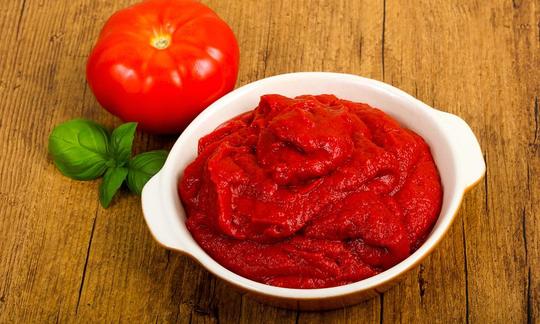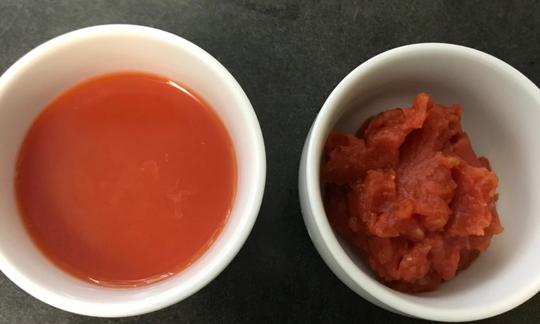Table of contents
Homemade tomato paste is made from the flesh of ripe tomatoes (preferably organic). Heating extends the shelf life, but does not make it raw.
Use in the kitchen
What is tomato paste? Tomato paste is a paste made from the concentrated pulp of ripe tomatoes. Homemade tomato paste, known as tomato puree in Switzerland and Paradeismark in eastern Austria, tastes slightly bitter when raw and has a fruity tomato taste when cooked. Depending on the seasoning used when making your own tomato paste, other flavors are added. Since tomatoes are cooked to make it, the aromatic paste is not considered raw food.
Unsalted tomato paste is mainly used to refine sauces and braised dishes. But tomato paste also gives soups, marinades and salad dressings a fruity note. Can you eat tomato paste raw? Without further processing, the tomato paste can be used raw as a delicious spread. If you like, you can refine the tomato paste withpepper, dried herbs (such as oregano, thyme or rosemary), pressed garlic, chili or ginger. You can also make your own ketchup with homemade tomato paste.
The riper the tomatoes, the better the tomato paste will taste in the end. It is therefore advisable to make tomato paste from home-grown, almost overripe tomatoes. Not all types of tomatoes are equally suitable for making tomato paste. Plum tomatoes and beefsteak tomatoes in particular have thick flesh and relatively little juice and are therefore ideal for this. Slightly sweet aromas can be found in cooked plumsteak tomatoes (e.g. the San Marzano varieties Agro and Plumito). A more intense aroma can be achieved by using the beefsteak tomatoes Marglobe or Berner Rose. Roma tomatoes are also very suitable. 1 Due to the high proportion of glutamic acid in ripe tomatoes 11, tomato paste contains the umami taste.
In addition to direct use in the kitchen, commercial tomato paste is used as a base for ketchup, tomato juice, tomato powder, tomato semolina or tomato flakes. Tomato pulp ( preserved, chopped tomatoes) is also used in the production of seasoning sauces and seasoning ketchup. This often consists of chopped, un-strained fruit components and leads to a greater consistency.
Making your own tomato paste
Can you make your own tomato paste? You can easily make your own tomato paste and avoid using ready-made products. There are various methods of making tomato paste. Here you will find a recipe for homemade tomato paste.
The main steps are: First, cut the ripe tomatoes (preferably organic) crosswise, blanch them, rinse them in cold water and peel off the skin, quarter them, remove the stalk and remove the seeds. Then cook the tomatoes over a low heat for about 30 minutes and can be pureed if necessary. Use a cloth to press the juice out of the pureed mass. The pulp remaining in the cloth is pasteurized in sterile jars, which extends the shelf life.
Vegan recipe for a tomato paste and celery spread
Ingredients (for 4 people): ½ celery root, 1 tbsp homemade tomato paste, 1 tbsp mustard, 1 tspherb vinegar, salt. To serve: breadcrumbs, margarine.
Preparation: Clean the celeriac, peel it and grate it finely. Mix with homemade tomato paste, mustard, herb vinegar and salt. Leave the whole thing to stand for about 15 minutes. Spread the margarine on slices of bread, pour the vegan tomato paste and celery spread over it and optionally garnish with chopped parsley. The spread also tastes good as a dip for vegetable sticks.
Vegan recipe for ketchup with tomato paste
Ingredients (for 1 jar): 1 teaspoon rapeseed oil, 200 g homemade tomato paste, 2 teaspoons onion powder, ½ teaspoon garlic powder, 100-150 ml water, 1-2 tablespoons apple cider vinegar, 2 tablespoons maple syrup, 1 teaspoon chili powder, 1 teaspoon salt.
Preparation: Briefly fry the tomato paste, onion powder and garlic powder in a pan heated with rapeseed oil. Deglaze with water and bring to the boil. Add apple cider vinegar, maple syrup, chili powder and salt and simmer for approx. 5 minutes. Season to taste if necessary. Pour into a clean, sealable jar and allow to cool. Store the vegan, homemade ketchup in the fridge and use within a week.
Vegan recipes with tomato paste (homemade) can be found under the note: " Recipes that have the most of this ingredient ".
| Not only vegans or vegetarians should read this: Vegans often eat unhealthily. Avoidable nutritional errors. |
Purchasing - Storage
If you don't want to make tomato paste yourself, you can of course buy it. Tomato paste is available commercially in tubes, tins or screw-top jars. You can buy it as single-concentrated tomato paste (14-22% dry matter, approx. 80% water content), double-concentrated tomato paste (28-30% dry matter, approx. 70% water content) or triple-concentrated tomato paste (36-40% dry matter, approx. 60% water content). 1.5 In Switzerland, the minimum dry matter content is set at 12, 24 and 36%. 8 There is also occasionally tomato paste with a dry matter content of over 40%.
You can find tomato paste in most supermarkets (such as Coop, Migros, Denner, Volg, Spar, Aldi, Lidl, Rewe, Edeka, Hofer, Billa etc.) and organic supermarkets (such as Denn's Biomarkt and Alnatura) all year round. There is salted and unsalted tomato paste. Organic tomato puree is often unsalted.
The availability of tomato paste varies depending on the size of the store, catchment area, etc. Our recorded food prices for the DA-CH countries can be found above under the ingredient image - and by clicking you can see their development at different suppliers.
Storage tips
Homemade, unsalted tomato puree should be stored in boiled, airtight jars in the refrigerator. This way, it will last for several weeks unopened. Once opened, you can extend the shelf life of the homemade tomato paste by pouring a thin layer of oil over the tomato paste in the jar. You can also freeze the homemade tomato paste in ice cube trays and use it in cooked dishes when needed.
Ingredients - Nutritional values - Calories
Homemade tomato paste contains various minerals such as potassium, iron and manganese, as well as vitamins such as vitamin C (ascorbic acid), vitamin E and niacin (ex vitamin B3). The amount of the ingredients changes according to the water content.
The content of L-glutamic acid and monosodium salt in ripe tomatoes is approximately 130-140 mg/100g of fruit. 11
The complete ingredients of tomato paste (homemade), the coverage of the daily requirement and comparison values with other ingredients can be found in our nutrient tables. In the article Nutrients explained you will get a detailed insight into the topic.
Health effects
Is tomato paste healthy? You can find out about the health benefits of tomato paste in the article " Tomato paste (unsalted) ".
Below we add the results of a 2020 study that investigated the differences in antioxidant activity, total phenolics and flavonoids in commercial and homemade tomato purees. The results indicated that commercial tomato purees were of higher quality in terms of their antioxidant value and phenolics and flavonoids content than their homemade counterparts. The fact that commercial tomato pastes are generally produced under controlled conditions, unlike homemade ones, may be a major reason for the differences. 2
Dangers - Intolerances - Side effects
Is tomato paste unhealthy? Tomatoes and especially processed tomato products such as tomato paste contain histamine and promote the release of the body's own histamine, which can cause problems in people with histamine intolerance. Test your tolerance limit carefully, ideally with a small portion of fresh tomatoes, or avoid them altogether. Low-histamine sweet peppers are a suitable substitute for tomatoes. Paprika paste can be used instead of tomato paste. 3
Ecological footprint - animal welfare
According to a 2020 study by the Institute for Energy and Environmental Research Heidelberg, commercial tomato paste has an ecological footprint of 4.3 kg CO 2 eq/kg. This is larger than that of fresh tomatoes (average 0.8 kg CO 2 eq/kg). 4 There are no studies showing how much the CO 2 footprint differs from commercial to homemade tomato purees. In the case of commercial tomato paste, the packaging has a significant influence on the total ecological footprint. 9 However, since the usual packaging is not required when making your own tomato paste, it can be assumed that the ecological footprint is smaller.
The amount of water required to produce 1 kg of commercial tomato paste is 713 litres. 10 We have not found any concrete figures for the water consumption of 1 kg of homemade tomato paste. The environmental impact also depends on the country of origin of the tomatoes - countries that naturally struggle with water shortages are more affected. With homemade tomato paste, it is easier to pay attention to the origin and cultivation method of the tomatoes. Ideally, you make it in season and buy regional tomatoes from outdoor cultivation - this saves unnecessary transport and energy from growing in a greenhouse. If you also buy organically grown tomatoes, you protect the environment by avoiding synthetic pesticides and herbicides, which not only have a negative impact on the environment, but also require a lot of energy during production.
Worldwide occurrence - cultivation
Making tomato paste from ripe, boiled tomatoes is a traditional method of preserving tomatoes. 5 The practice originates from Emilia-Romagna, a region in northern Italy, and has remained almost unchanged to this day. Tomato paste and the method of its production spread in the 19th century, when many Italians emigrated. 6
Further information
In Switzerland, tomato paste is sometimes also called tomato puree, which can lead to terminological confusion. In Germany, tomato puree refers to peeled, cored, strained, but not concentrated tomatoes. It is often equated with "passed tomatoes". 7
In English, tomato puree and tomato paste are similar in terms of production: Both consist of peeled, pitted tomatoes, with a cooking time of several hours. However, they differ in concentration: puree is significantly thinner, so has a solids content (TSS = total soluble solids) of 8-24%. A tomato paste is said to contain 24% or more. An extra heavy tomato paste with a TSS of over 38.5% can be compared to the "tomato paste" found in the DA-CH countries. 11 An international quality standard, CODEX STAN 57-1981, designates tomato concentrate with more than 8% TSS as such and distinguishes tomato puree from tomato paste from 24% TSS. 12
Alternative names
What is tomato puree and what is paradeismark? In Switzerland, tomato paste is called tomato puree, in eastern Austria it is called paradeismark (paradeis = tomato). Another name is tomato concentrate. Tomato paste is highly concentrated tomato paste.
The English name for homemade tomato paste is homemade tomato paste.
Bibliography - 12 Sources
| 1. | Mein-schoener-garten de: Tomatenmark selber machen: So geht’s. 2022. |
| 2. | Katırcı N, Işık N, Güpür Ç, Guler HO, Gursoy O, Yilma Y. Differences in antioxidant activity, total phenolic and flavonoid contents of commercial and homemade tomato pastes. Journal of the Saudi Society of Agricultural Sciences. 2020;19(4):249–54. |
| 3. | Histaminta de: Tomaten bei Histamin-Intoleranz. |
| 4. | Reinhardt G, Gärtner S, Wagner T. Ökologische Fussabdrücke von Lebensmitteln und Gerichten in Deutschland. Institut für Energie- und Umweltforschung Heidelberg ifeu. 2020;1-22. |
| 5. | Bayerisches Landesamt für Gesundheit und Lebensmittelsicherheit. Ausgewählte chemische Elemente in Tomatenmark - Untersuchungsergebnisse 2016. |
| 6. | Malet JB. Täglich Tomate. Globaler Einheitsbrei in Dosen. In: Le monde diplomatique. 2017 |
| 7. | Tomaten-welt de: Was ist eigentlich Tomatenpüree? |
| 8. | Verordnung des Eidgenössisches Departements des Innern (EDI) über Getränke (Stand 2020). |
| 9. | Faharani SS, Soheilifard F, Raini MGN, Kokei D. Comparison of different tomate puree production phases from an environmental point of view. The International Journal of Life Cycle Assessment. 2019. |
| 10. | Mekonnen MM, Hoekstra AY. The green, blue and grey water footprint of crops and derived crop products. Hydrol. Earth Syst. Sci. 2011; 15: 1577-1600. |
| 11. | Pauliukaite R, Zhylyak G, Citterio D, Spichiger-Keller UE. L-glutamate biosensor for estimation of the taste of tomato specimens. Anal Bioanal Chem. September 2006;386(2):220–7. |
| 12. | IIFPT Indian Institute of Food Processing Technology Ministry of Food Processing Industries. Processing of tomato products - Tomato Puree, Paste, Ketchup and Sauce. Govt. of India. 2020. |












Comments